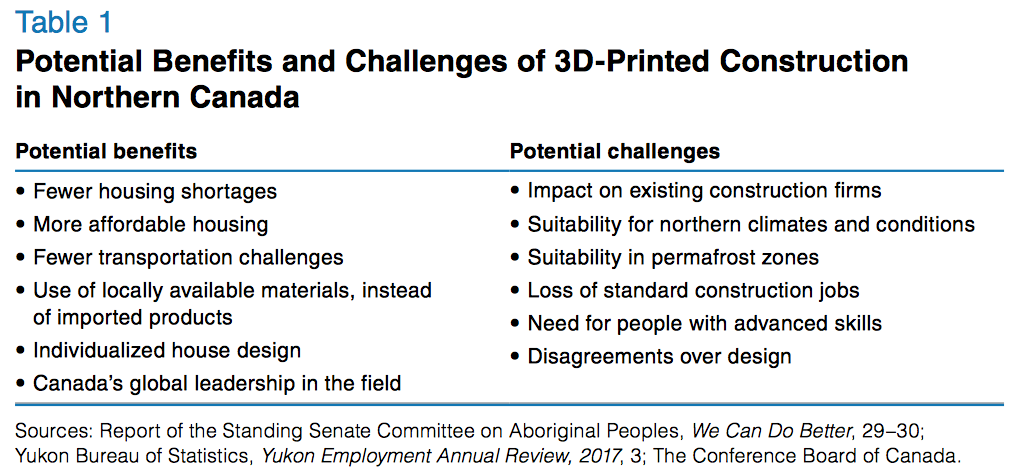The Conference Board of Canada, a not-for-profit think tank based in Ottawa, has released a report discussing 3D printing’s potential in construction. Targeting Canada’s North, which accounts for roughly 39% of the country’s entire land area but only housing 1% of its total population, this research is seeking to improve people’s quality of life by providing more cost effective homes.
As stated in the preface to the report:
“Ultimately, the country needs to determine if 3D printed construction is suited to Northern Canada and if its use can contribute to cost reductions and improvements in the availability, quality, and adequacy of housing—critical problems for the North that are in need of innovative solutions.”
Construction in subarctic conditions
As an extremely harsh environment, circulating arctic and subarctic temperatures, building in Northern Canada is extremely challenging to conventional methods of construction. As a result, these challenges are reflected in the cost of building in the area. To construct a public housing unit in Nunavut, home to indigenous Inuit people, and accessible for much of the year only by plane or boat, it would cost up to $550,000. This is three times the cost of building the same unit in the Greater Toronto Area which, by contrast, is the most populous area in Canada.

And so, if you could replace a large portion of the materials and equipment needed for this task, plus the hours and personnel required for manual labor, with a machine that does it all and only a handful of operators, you can see how 3D printing could become effective.
Stefan Fournier, Associate Director of Northern and Aboriginal Policy at the Conference Board of Canada, explains, “There is a severe shortage of suitable housing and appropriate buildings across the North, and the high cost of standard construction and short transportation season have prevented governments from coming close to meeting the urgent need for housing in the North,”
“While it’s not yet clear whether the technology can address or overcome some of the key issues that construction projects must contend with in Northern and remote environments, it’s not hard to see how 3D printing construction could potentially have a meaningful impact in Canada’s North.”
Is 3D printing ready?
Revolutionary Building for the North: 3D Printing Construction is part of the board’s Cool Ideas series to explore the opportunities of emerging technologies and discover which of those have the most value to the people of Canada.
In the report, the board reviews a number of active and familiar 3D printed construction projects, including Apis Cor’s 24 hour house, Qingdao Unique Products Develop Co.’s large-scale 3D printer, and works from the U.S. Defense Advanced Research projects Agency (DARPA.) However, these projects, by working with cement, many not yet be directly transferable to the North.
As stated in the report “Concrete may not be ideal for ensuring heat efficiency in extreme cold or structural integrity under snow loads.” An ability to source appropriate material on site could also prove challenging.
This is all with respect to the views and needs of the recipients of such structures too. “Techno-enthusiasm is commonplace around innovation, technology, and new devices,” the report states, “But these passions must be balanced by a sense of reality and a sober assessment of the context in which the new technology is to be applied.”

Points of action
After outlining the potential challenges of introducing 3D printing to construction in Canada’s North, the board reaches five priority issues to be addressed in the new steps of this research.
1. Develop an Enabling Policy Environment – i.e. public funding for the housing, due to the absence of economy in the area.
2. Determine Whether 3D Printing is a Viable Option for the North – conducting theoretical and practical experiments into the technology’s suitability.
3. Ensure Research is Driven by Northerners, for Northerners, in a Northern Context – developing a Northern consortium to ensure any decisions are made in the people’s best interests.
4. Identify and Prepare for Negative Outcomes as Well as New Opportunities
5. Don’t Give Up On Innovation – as the report concludes: “Should the value and viability of 3D printing technology be more limited than is hoped, we should not give up on the critical objective of identifying new and innovative ways to address the significant housing issues that confront the North.”
For updates on the 3D printed construction research, and other related news subscribe to the 3D Printing Industry newsletter, follow us on Twitter and like us on Facebook. Visit our 3D Printing Jobs site to pursue your next career move.
Featured image shows screengrab of Revolutionary Building for the North: 3D Printing Construction report. Image via The Conference Board of Canada


